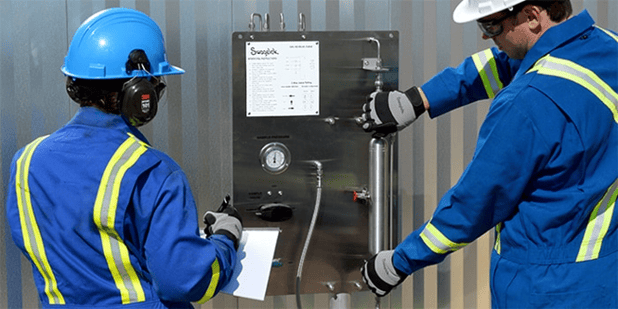Share this
Gas Sampling Conditioning Systems for Accurate Sample Analysis
by Morgan Zealear on 8/18/22 9:00 AM

Many industries depend on gas sampling to maintain safety and regulatory compliance. Gas sampling indicates the composition of gases in use. Deviations in gas composition may indicate that impurities are entering processes or the presence of a gas leak. Impurities in the system pose risks to components that are designed for specific gasses at specific temperatures and pressures. Gas leaks are worrisome as they pose safety risks to workers and may pollute the environment.
Accurate gas sampling is necessary to prevent:
- component failure;
- excessive repair and replacement costs;
- loss of profits due to poor product yield;
- dangerous working environments; and
- fines and legal issues posed by violating work and environmental regulations.
Gas sampling is critical to the safety of workers and the continual operation of facilities. However, to analyze a gas sample, a gas sample conditioning system must be used, and a gas sample method determined. The gas sample conditioning system allows the gas to be prepared for analysis and there are several ways this system conditions gas for analysis. Prior to gas sample conditioning, there are several methods to collect a gas sample. The most effective method to utilize is dependent on the type of facility and the facility operations.
In this article, we will discuss the ways gas samples are conditioned, the methods for gas sampling, and how Swagelok Northern California can help with your gas sampling conditioning system and gas sampling needs.
The Role of Gas Sampling Conditioning Systems
The gas sampling conditioning system is important to get a proper analysis of gas. The system standardizes samples by controlling variables that could potentially confound the analysis. Further, by controlling these variables, the gas sampling conditioning system minimizes the risk of gas analysis sensors being damaged—which would cause significant issues with analysis.
The gas sampling conditioning system controls the following:
- Pressure and temperature: When conducting an analysis of a particular gas, the gas needs to get to a sensor for analysis. If the pressure or temperature is outside of acceptable ranges, leaks may occur, and the chemical composition of the gas could become altered. This is due to varying molecular weights of molecules influencing their speed of movement, fractionation due to condensation, and emission from leaks. Further, temperature and pressure issues may damage components—such as sensors—which are needed for an accurate reading.
- Process sample filtration: To limit difficulties in analysis, gas samples are often separated by their chemical composition. Though this can be done by shape or charge, most often gas chemicals are separated by either molecular size or molecular weight. This separation technique allows for easier analysis as each component of the gas is purified for analysis before determining the overall composition of the gas. Failure to properly separate gas chemicals may result in erroneous readings due to impurities indicating more or less of certain chemicals found in the gas.
- Standardized gas sampling transport line: The transport of the gas can be fast loop or multi-stream switching. The fast loop system transports samples rapidly for analysis. It typically only uses a small subsample of the gas sample for analysis, which creates additional variability in analysis but increases speed. The unused gas is returned to the system. This type of gas sampling transport line is recommended in a gas sampling conditioning system if continual analysis is needed for a system with a high degree of variability in the environment. The multi-stream switching is useful for analyzing many samples of gas at the same time. Though it can be continuous, it is not as fast as the fast loop system. However, it is cost-effective and more efficient when multiple samples are needed to be analyzed.
Utilizing a gas sampling condition system is not the only aspect of gas analyses that should be considered; facilities also need to consider the method for collecting gas samples.
Methods for Gas Sampling
Gas sampling methods generally fall into three different types: grab sampling, passive sampling, and active sampling. These types of sampling differ in the amount of labor needed as well as when and how that labor is utilized.
Grab Sampling
Grab sampling (also known as spot sampling) involves taking a small sample of the overall gas. This sample is then shipped to a laboratory for analysis. The small sample should be representative of the overall gas in the system. To make sure a grab sample is a truly representative sample, a gas grab sample should occur at predetermined specified times that will capture a fair representation of the overall gas in the system. One benefit of gas grab sampling is that operational costs are lower because it does not require continual monitoring of gas. However, this sampling method is labor intensive and requires a well-thought-out plan to get samples that will accurately represent all the gasses in process.
Passive Sampling
Passive sampling continually monitors gas as gas molecules diffuse across gas detectors. A sorbent is used on the detectors, and this allows the concentration of gas molecules to be determined. Passive sampling provides the additional benefit of continually monitoring the gas and this could be important if gas composition is not consistent. Though passive sampling is less labor intensive, it requires additional costs for detectors and maintenance when compared to grab sampling.
Active Sampling
Active sampling continually monitors gas by actively pumping gas into a sorbent medium. This type of sampling needs additional equipment such as gas detectors and pumps. Like passive sampling, the continual monitoring of gas is helpful if gas concentrations are inconsistent. Though active sampling requires additional equipment, it is less influenced by environmental conditions (temperature and pressure) than passive sampling. Thus, active sampling provides a more accurate sample for analysis in some situations.
The gas sampling condition system—as well as the components for the method of gas sampling employed—need to be successfully integrated into existing infrastructure. Integrating a gas sampling condition system can be complex due to the type of gasses being used, the temperature and pressure reached, and the capabilities of the existing infrastructure. A local expert can help with implementing a gas sampling condition system and recommending the most effective method for gas sampling.
Local Support for Your Gas Sampling Conditioning System Needs
Gas sampling plays a critical role in work safety and environmental compliance in Northern California. At Swagelok, we’ve had a local presence for more than five decades, in-depth knowledge of the grab sampling requirements of Northern California refineries, and a team of experts and certified technicians. We can design and install gas sampling assemblies and components to meet your needs. We can also recommend components for a passive or active sampling system dictated by a third-party analyzer.
So, whether you need a replacement for a high-pressure hose transporting gas from process to sampling station, additional sample cylinders to accommodate more frequent sampling schedules, or a better design for a gas sampling assembly, Swagelok can quickly address all your procurement needs, quickly and reliably.
To find out more about how Swagelok Northern California can help you with your gas sampling conditioning needs, contact our team today by calling 510-933-6200.

About Morgan Zealear | Product Engineer, Assembly Services
Morgan holds a Bachelor of Science in Mechanical Engineering from the University of California at Santa Barbara. He is certified in Section IX, Grab Sample Panel Configuration, and Mechanical Efficiency Program Specification (API 682), and he is well versed in B31.3 Process Piping Code. Before joining Swagelok Northern, he was a manufacturing engineer at Sierra Instruments, primarily focused on capillary thermal meters for the semiconductor industry (ASML).
Share this
- Archive (465)
- Assembly Services (207)
- About (100)
- Seal Support Systems (96)
- Best Practices (88)
- Training Services (74)
- Fittings (51)
- Semiconductor Applications (49)
- Hoses and Flexible Tubing (47)
- Regulators (44)
- Tubing (42)
- Grab Sampling Systems (32)
- Sampling Systems (32)
- Gas Systems (30)
- Services (30)
- Downloads (29)
- Valves (24)
- Application Support (18)
- Orbital Welding (17)
- Case Studies (13)
- Steam Systems (13)
- Frequently Asked Questions (12)
- Tools (12)
- Measurement Devices (7)
- Subsystems (6)
- Thermal Management (6)
- September 2023 (1)
- August 2023 (2)
- June 2023 (1)
- March 2023 (3)
- February 2023 (3)
- January 2023 (4)
- December 2022 (4)
- November 2022 (4)
- October 2022 (4)
- September 2022 (1)
- August 2022 (3)
- July 2022 (2)
- June 2022 (4)
- May 2022 (1)
- April 2022 (2)
- March 2022 (1)
- February 2022 (2)
- January 2022 (3)
- December 2021 (1)
- November 2021 (6)
- October 2021 (6)
- September 2021 (8)
- August 2021 (4)
- July 2021 (3)
- June 2021 (6)
- May 2021 (6)
- April 2021 (7)
- March 2021 (5)
- February 2021 (4)
- January 2021 (6)
- December 2020 (5)
- November 2020 (6)
- October 2020 (6)
- September 2020 (8)
- August 2020 (7)
- July 2020 (8)
- June 2020 (8)
- May 2020 (6)
- April 2020 (9)
- March 2020 (7)
- February 2020 (10)
- January 2020 (21)
- December 2019 (23)
- November 2019 (21)
- October 2019 (22)
- September 2019 (21)
- August 2019 (22)
- July 2019 (23)
- June 2019 (20)
- May 2019 (23)
- April 2019 (22)
- March 2019 (21)
- February 2019 (20)
- January 2019 (21)
- December 2018 (14)
- November 2018 (19)
- October 2018 (23)
- September 2018 (17)
- August 2018 (29)
- July 2018 (11)
- June 2018 (6)
- May 2018 (5)
- April 2018 (4)
- March 2018 (5)
- February 2018 (3)
- January 2018 (3)
- December 2017 (2)
- November 2017 (4)
- October 2017 (3)
- September 2017 (2)
- August 2017 (6)
- July 2017 (4)
- June 2017 (4)
- May 2017 (4)
- April 2017 (3)
- March 2017 (4)
- February 2017 (3)
- January 2017 (3)
- December 2016 (3)
- November 2016 (3)
- October 2016 (3)
- September 2016 (5)
- August 2016 (5)
- July 2016 (4)
- June 2016 (5)
- May 2016 (3)
- April 2016 (4)
- March 2016 (5)
- February 2016 (11)
- January 2016 (1)
- December 2015 (3)
- November 2015 (4)
- October 2015 (3)
- September 2015 (4)
- August 2015 (4)
- July 2015 (8)
- June 2015 (5)
- May 2015 (3)
- April 2015 (4)
- March 2015 (4)
- February 2015 (3)
- January 2015 (4)
- December 2014 (2)
- November 2014 (3)
- October 2014 (4)
- September 2014 (4)
- August 2014 (4)
- July 2014 (5)
- June 2014 (4)
- May 2014 (4)
- April 2014 (5)
- March 2014 (4)
- February 2014 (3)
- January 2014 (4)
- December 2013 (5)
- November 2013 (3)
- October 2013 (4)
- September 2013 (3)
- August 2013 (5)
- July 2013 (5)
- June 2013 (5)
- May 2013 (3)
- April 2013 (6)
- March 2013 (4)
- February 2013 (4)
- January 2013 (8)
- December 2012 (4)
- November 2012 (6)
- October 2012 (6)
- September 2012 (4)
- August 2012 (4)
- July 2012 (4)
- June 2012 (4)

.webp?width=210&height=70&name=StickyLogo%20(5).webp)